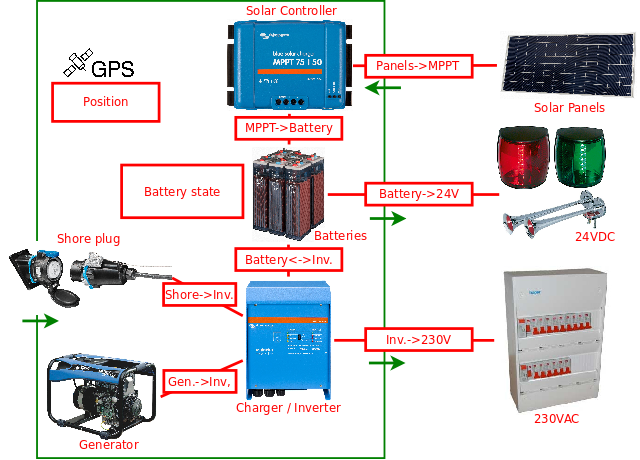After some hardware issues (broken USB prolongator, due to my own clumsiness), I've connected the MPPT solar controller to the Raspberry Pi. Compared to the situation as described in the previous post, it means I get not only measures at the battery connectors, but also what gets out of the solar panels. I still miss some measures at the inverter's boundaries in order to get the whole picture, but it's getting clearer.
Here's a diagram with all of the boxes I'd like to fill:
 What ought to be measured in the electrical production system.
What ought to be measured in the electrical production system.
What misses
The Battery monitor gives me direct access to "Battery state" and to "MPPT->battery"+"Battery<->inv."-"Battery->24V". By connecting the MPPT, I get "MPPT->battery", so I can compute "Battery<->inv."-"Battery->24V". In a first approcimation I'll consider that most of the power is used by the inverted, so "Battery->24V"~0W. This will be corrected when I'll be able to read the inverter input directly.
Position is returned directly by the GX440's integrated GPS. It can be returned on the local network on a configurable socket, and/or to AirVantage servers.
"Inverter->230V" is very close to "Battery<->inv." (efficiency is around 95%) as long as shore and genset are off. "Shore->inv."+"Gen.->inv." can be deduced from "Battery<->inv." and "Inv->230V", both of whom will be provided by the inverter. Discriminating between shore and genset can be done by checking whether the genset's battery circuit is switched on, or by clamping cheap AC current sensors around cables.
Still enough
Anyway, what's important to check is approximately how much comes from the panels, at what time, and how much is consumed by big appliances, so "MPPT->battery" and a reasonable estimate of "Battery<->inv."; with those we can take the key decisions: should we rather move to the shade or switch conditioned air on? Do I need to switch the genset on to use the angle grinder? et.
Looking at some curves
Here's a "Battery<->inv." curve:
 Power balance at battery boundaries.
Power balance at battery boundaries.
We see that from around 11:00AM, when the sun gets over the platanus trees, the batteries are filled with 600-700W of power. That's actually 800-900W from the panels, with about 100W of concurrent consumption (cf. below). We see a couple of short but intense discharges, typically due to washing machine heaters and pumps.
From around 2PM, we see a nice decreasing asymptote to the curve: the battery being nearly full (94% at 2PM), it accepts less incoming power, so the MPPT artificially raises the impedence, hence the voltage, presented to the panels, to reduce their production. It's more obvious on the solar production curve:
 Power form MPPT to battery.
Power form MPPT to battery.
The deliberate change of mode is even more striking if we check directly the voltage at the panels:
 Tension on panels.
Tension on panels.